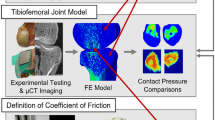Abstract
The biomechanical relationship between the articular cartilage defect and knee osteoarthritis (OA) has not been clearly defined. This study presents a 3D knee finite element model (FEM) to determine the effect of cartilage defects on the stress distribution around the defect rim. The complete knee FEM, which includes bones, articular cartilages, menisci and ligaments, is developed from computed tomography and magnetic resonance images. This FEM then is validated and used to simulate femoral cartilage defects. Based on the obtained results, it is confirmed that the 3D knee FEM is reconstructed with high-fidelity level and can faithfully predict the knee contact behavior. Cartilage defects drastically affect the stress distribution on articular cartilages. When the defect size was smaller than 1.00 cm2, the stress elevation and redistribution were found undistinguishable. However, significant stress elevation and redistribution were detected due to the large defect sizes (⩾1.00 cm2). This alteration of stress distribution has important implications relating to the progression of cartilage defect to OA in the human knee joint.
Similar content being viewed by others
References
Peña E, Calvo B, Martinez M A, et al. A three-dimensional finite element analysis of the combined behavior of ligaments and menisci in the healthy human knee joint [J]. Journal of Biomechanics, 2006, 39(9): 1686–1701.
Donahue T L, Hull M L, Rashid M M, et al. A finite element model of the human knee joint for the study of tibio-femoral contact [J]. Journal of Biomechanical Engineering, 2002, 124(3): 273–280.
Shirazi R, Shirazi-adl A, Hurtig M. Role of cartilage collagen fibrils networks in knee joint biomechanics under compression [J]. Journal of Biomechanics, 2008, 41(16): 3340–3348.
Shirazi R, Shirazi-adl A. Computational biomechanics of articular cartilage of human knee joint: Effect of osteochondral defects [J]. Journal of Biomechanics, 2009, 42(15): 2458–2465.
Yang N H, Canavan P K, Nayeb-hashemi H, et al. Protocol for constructing subject-specific biomechanical models of knee joint [J]. Computer Methods in Biomechanics and Biomedical Engineering, 2010, 13(5): 589–603.
Peña E, Calvo B, Martinez M A, et al. Finite element analysis of the effect of meniscal tears and meniscectomies on human knee biomechanics [J]. Clinical Biomechanics, 2005, 20(5): 498–507.
Widuchowski W, Widuchowski J, Trzaska T. Articular cartilage defects: Study of 25 124 knee arthroscopies [J]. The Knee, 2007, 14(3): 177–182.
Papaioannou G, Demetropoulos C K, King Y H. Predicting the effects of knee focal articular surface injury with a patient-specific finite element model [J]. The Knee, 2010, 17(1): 61–68.
Li G, Lopez O, Rubash H. Variability of a three-dimensional finite element model constructed using magnetic resonance images of a knee for joint contact stress analysis [J]. Biomedical Engineering, 2001, 123(4): 341–346.
Meakin J R, Shrive N G, Frank C B, et al. Finite element analysis of the meniscus: The influence of geometry and material properties on its behaviour [J]. The Knee, 2003, 10(1): 33–41.
Pelletier J P, Raynauld J P, Berthiaume M J, et al. Risk factors associated with the loss of cartilage volume on weight-bearing areas in knee osteoarthritis patients assessed by quantitative magnetic resonance imaging: A longitudinal study [J]. Arthritis Research and Therapy, 2007, 9(4): R74.
Weiss J A, Gardiner J C. Computational modeling of ligament mechanics [J]. Critical Review in Biomedical Engineering, 2001, 29(3): 303–371.
Yang N, Nayeb-hashemi H, Canavan P K. The combined effect of frontal plane tibiofemoral knee angle and meniscectomy on the cartilage contact stresses and strains [J]. Annals of Biomedical Engineering, 2009, 37(11): 2360–2372.
Sathasivam S, Walker P S. A computer model with surface friction for the prediction of total knee kinematics [J]. Journal of Biomechanics, 1997, 30(2): 177–184.
Karataglis D, Green M A, Learmonth D J. Autologous osteochondral transplantation for the treatment of chondral defects of the knee [J]. The Knee, 2006, 13(1): 32–35.
Li G, Gil J, Kanamori A, et al. A validated three-dimensional computational model of a human knee joint [J]. Journal of Biomechanical Engineering, 1999, 121(6): 657–662.
Bowers M E, Tung G A, Fleming B C, et al. Quantification of meniscal volume by segmentation of 3T magnetic resonance images [J]. Journal of Biomechanics, 2007, 40(12): 2811–2815.
Fukubayashi T, Kurosawa H. The contact area and pressure distribution pattern of the knee: A study of normal and osteoarthrotic knee joints [J]. Acta Orthopaedica Scandinavica, 1980, 51(6): 871–879.
Walker P S, Erkman M J. The role of the menisci in force transmission across the knee [J]. Clinical Orthopaedics and Related Research, 1975 (109): 184–192.
Bendjaballah M Z, Shirazi-Adl A, Zukor D J. Biomechanics of the human knee joint in compression: Reconstruction, mesh generation and finite element analysis [J]. The knee, 1995, 2(2): 69–79.
Radin E L, Burr D B. Hypothesis: Joints can heal [J]. Seminars in Arthritis and Rheumatism, 1984, 13(3): 293–302.
Jackson D W, Lalor P A, Aberman H M, et al. Spontaneous repair of full-thickness defects of articular cartilage in a goat model: A preliminary study [J]. Journal of Bone and Joint Surgery, 2001, 83(1): 53–64.
Hughston J C, Hergenroeder P T, Courtenay B G. Osteochondritis dissecans of the femoral condyles [J]. Journal of Bone and Joint Surgery, 1984, 66(9): 1340–1348.
Buckwalter J A, Brown T D. Joint injury, repair, and remodeling: Roles in post-traumatic osteoarthritis [J]. Clinical Orthopaedics and Related Research, 2004 (423): 7–16.
Peña E, Calvo B, Martinez M A, et al. Effect of the size and location of osteochondral defects in degenerative arthritis: A finite element simulation [J]. Computers in Biology and Medicine, 2007, 37(3): 376–387.
Author information
Authors and Affiliations
Corresponding author
Additional information
Foundation item: the National Natural Science Foundation of China (No. 81071235) and the Medicine and Engineering Interdisciplinary Fund of Shanghai Jiaotong University (No. YG2010MS26)
Rights and permissions
About this article
Cite this article
Dong, Yf., Hu, Gh., Zhang, Ll. et al. Accurate 3D reconstruction of subject-specific knee finite element model to simulate the articular cartilage defects. J. Shanghai Jiaotong Univ. (Sci.) 16, 620–627 (2011). https://doi.org/10.1007/s12204-011-1199-z
Received:
Published:
Issue Date:
DOI: https://doi.org/10.1007/s12204-011-1199-z




